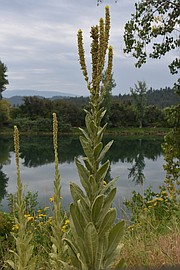Common mullein: An amazing, versatile plant
As I was taking a walk earlier this summer, I noticed along the bank of the Kootenai River some green, soft-looking plants which appeared to be the lambs-ear plant, with which many of us are familiar.
After closer inspection, and consulting with the County Extension office, the plant I was looking at was the Common mullein or Verbascum thapsus. It quickly came to me that some locals refer to the plant as “Cowboy’s Toilet Paper.” Then the light bulb went off — could this be Mother Nature’s answer to our COVID-19 toilet paper shortage? But I quickly wiped that out of my mind.
Besides Cowboy’s Toilet Paper, you may have heard it referred to as Quaker’s rouge, candle wick, flannel leaf, velvet dock, big taper, bunny’s ear, shepherd’s club, or poor man’s blanket. These names commonly reflect some characteristic the plant exhibits, such as the flower stalk or leaf texture.
The history of this plant is fascinating. Common mullein traces its roots back to Europe as it was planted in gardens for its medicinal purposes as a diuretic, pain relief and healing of abrasions. Mullein is applied to the skin for wounds, burns, bruises, frostbite and skin infections. The leaves are used topically to soften and protect the skin. Interesting enough, since Quaker women weren’t allowed to wear make-up, they would rub the hairy leaves on their cheeks to create a homemade blush look. Hence the name Quaker’s rouge.
Like many plants, it escaped the confines of cultivation and is now a weed which can be found across the United States. In Boundary County, we still list it as a noxious week and tend to see it in disturbed areas such as railroad right-of-ways, roadsides, fence rows, ditches and pastures. In fact, it is one of the first weeds to germinate when an area is disturbed.
It prefers sunny, hot, dry conditions. It grows quicker than native plants so it can quickly take over a newly disturbed area. Common mullein is a minor problem in cropping systems because it is unable to survive cultivation and is intolerant of shade. However, it can persist and remain problematic in overgrazed pastures due to it generally being avoided by livestock.
Common mullein is a spring-germinating biennial. In the first year, it produces a large basal rosette — 7 to 24 inches of large, furry leaves with a substantial crown. The leaves are covered by dense hairs, making it similar to felt fabric. Those hairs make it very undesirable to livestock and wildlife that might feed on the foliage of the plant. The rosette overwinters, and in the second year, it produces a single, thick, erect flowering stem with yellow flowers reaching upward to 5 feet in height.
The flowers are present from June through September. The flowers are sessile on one or two terminal cylindrical spikes (7-19 inches in length by 1 3/16 inches wide). Individual flowers are just under 1 inch in diameter and have fused yellow petals with five lobes.
A single plant can produce up to 175,000 seeds and those seeds can remain viable up to 35 years. The seeds have wavy ridges alternating with deep grooves that resemble corn cobs. The seeds are typically 1/32 inch in length. After flowering the plant dies, leaving the tall stem, and the dead stems can persist for more than a year.
French author Marcel Proust once said, “The real voyage of discovery is not in seeking new landscapes but in having new eyes.” The coronavirus pandemic is providing us an opportunity to see the world with a new set of eyes. As we distance ourselves socially, I encourage you to get outside and take a walk.
Enjoy Boundary County and all its beauty!



